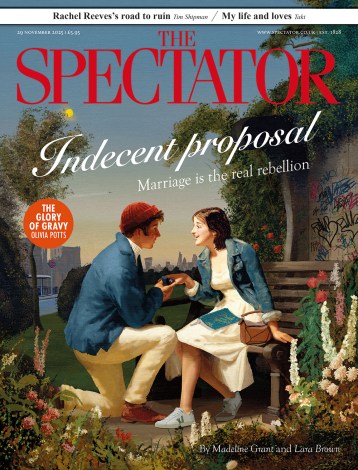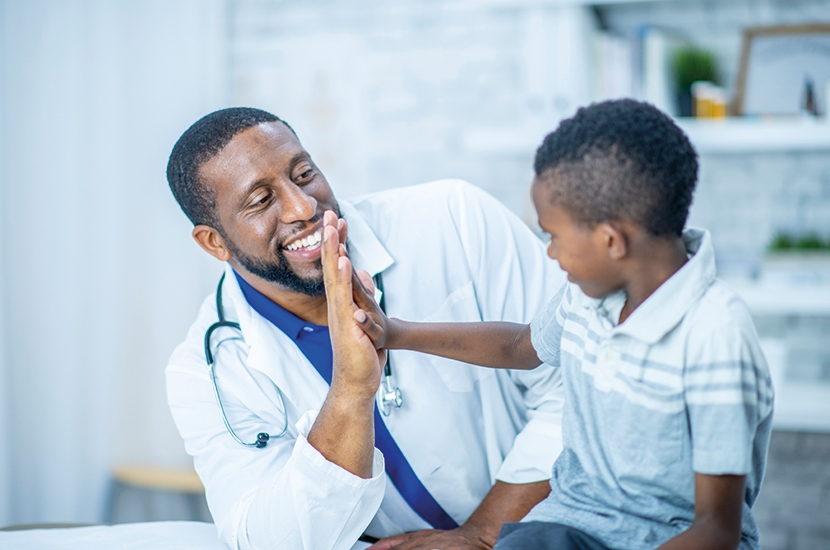It was nine years ago, in a windowless room in Great Ormond Street Hospital, that I first heard the words: ‘I think your son has something called Duchenne muscular dystrophy.’
I tried to comprehend what the consultant was telling me: the terminal diagnosis of my child. My son Eli, who looked like any other healthy three-year-old, had a broken gene inside him, the dystrophin gene. It meant that his muscles would stop working during his short lifetime. By 12 or 13 he could be in a wheelchair. In his late teens, in what should be the prime of his life, he would lose the use of his arms and hands. And sometime in his twenties, his heart and lungs would fail. His mind — his beautiful, inquisitive mind — was not affected. And for me this was one of the worst things: that he would be alive, inside a body that was dying on him.
Looking back, I wish the doctors had given me a diagnosis that day too. That the consultant had said to me: ‘Your son has Duchenne muscular dystrophy, and you now have anticipatory grief disorder.’ Just something, anything, to see me through the next few hours, days, weeks and months. I needed to be told: you are going to have to make yourself strong, because you are going to have to teach him how to live, while you watch him die.
I speak to many newly diagnosed families: they all experience this same seismic shock. And it happens to two families — almost exclusively boys and their parents — every single week of the year in the UK.
To see your child slip through your fingers, and be powerless to stop it, robs you of every instinct you have as a parent
At that time, I was a correspondent and anchor for Channel 4 News and CNN. Overnight, I went from covering other people’s tragedies to being at the centre of my own. And I could not see a way out.
Bit by bit, I found the strength to begin to research. And the subject of gene therapy kept popping up. I asked Eli’s doctors. They told me not to pin my hopes on this. Gene therapy would be unlikely to happen in his lifetime.
But by then, I had begun to learn to never take no for answer. I had had the amazing good fortune to meet some truly spectacular mothers who had decided to fight. One, a woman called Annie Ganot, had moved to Boston after her son Eytani was diagnosed with DMD. She and her husband, Ilan Ganot, set up a drug development company, Solid Bioscience, with the sole mission of making treatments a reality for DMD.
I also founded a patient organisation, now called Duchenne UK, with Alex Johnson, who also runs Joining Jack and is mum to Jack who has DMD. Together with our friend Kerry Rosenfeld from the Duchenne Research Fund, we invested $5 million in Solid Biosciences’ nascent gene therapy programme.
In 2018 they dosed their first patient. And I cannot begin to describe the amazing rush of emotions on hearing this news. Was this the herald of a new dawn?
Gene therapy has the potential to transform a diagnosis of DMD, along with many other long-term and even fatal diseases. The holy grail of gene therapy is that it’s a one-time treatment that fixes the broken gene for good. Strimvelis was the first stem cell gene therapy to do this, for patients with the very rare disease, ADA-SCID (severe combined immunodeficiency due to adenosine deaminase deficiency).
The dream is ultimately to do that for a host of diseases, so that the gene is fixed at birth and the child goes on to live their life. However, there are still major hurdles to overcome, which means that, currently, many sufferers see gene therapy as a treatment, not a cure. Nevertheless, a gene therapy treatment has the powerful ability to transform an unbeatable and incurable condition into something you can live with, rather than something you die from.
There are only a few experimental treatments aimed at addressing the disease’s underlying genetic cause. For those suffering from DMD, an extra five years walking in your teenage years would be transformational and reduce the need for support at school and at home. Another major gain in most cases is that parents would be able to stay in work longer — the social and economic benefits are huge.
My worries centre around capacity: both in terms of rolling out gene therapy trials, and who will have access to limited supplies. This applies to all diseases that can be treated by gene therapy. Duchenne UK has tackled this for traditional medicines with the establishment of DMD Hub, a network of clinical trial centres that we set up and have invested more than £2 million in. The Hub is helping to prepare UK sites for gene therapy too.
And we need to focus our attention on the reimbursement system, which was not designed for ‘one time’ treatments such as gene therapy. Regulators need to come up with new and forward-looking ways to assess uncertainty, to allow these one-off treatments the chance of being reimbursed. We are waiting with hope for these trials to arrive in the UK, for them to succeed, and for them to be approved and reimbursed, so that every eligible patient can benefit.
My son is now 13 and he is a wonder. He hasn’t let Duchenne stop him and charms everyone he meets. But as a mother I can’t help but think that this disease goes against the natural order of life. To see your child slip through your fingers, and be powerless to fight, robs you of every instinct you have as a parent: the instinct to protect and nurture your child. This is our story, and it reflects the countless stories of families across the UK, diagnosed with diseases that access to gene therapy could successfully treat.
If gene therapy can do anything to restore the natural order, we must do everything we can to make sure it succeeds.
This article first appeared in a Spectator supplement: The evolution of gene therapy. Sponsored by bluebird bio.






Comments